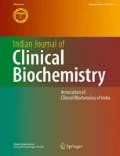Abstract
Experimental model of chronic renal failure in rats have been described by many authors and has also been widely used in various studies. Many of these methods used highly sophisticated instruments which was difficult in our settings. The resection model was ideal in our experimental set-up, but this model had the risk of excessive bleeding and hypovolemia. In our study we used a combination of partial resection and ligation of the renal artery to create two models of stable uremia A and Moderate uremia B. Severe uremia. Both these models were compared with a sham operated group which served as controls. Following surgical procedure, the development of uremia was monitored by serial estimation of blood urea and serum creatinine levels that were measured at regular intervals (bi-weekly). From two weeks onwards the animals in the experimental group showed a significant elevation in the serum urea levels and a consistent elevation in the serum creatinine levels upto eight weeks when compared to the animals in the sham operated group. We established a modified method of producing renal failure which can be maintained for a period of six weeks. This model is simple, reproducible and less complicated that can be used for several studies relating to renal failure in the field of research.
References
Liu ZC, Chow KM, Chang TM. Evaluation of two protocols of Uremic rat model partial nephrectomy & infarction. Renal Failure 2003; 25(6):935–943.
Ormrod D, Miller T. Experimental Uremia: Description of a model producing varying degree of stable Uremia. Nephron 1980; 26:249–254.
Sterner G. Experimental Chronic renal failure. Nephron 1979;24(4):207–208.
Morrison AB. Experimentally induced chronic renal insufficiency in the rat. Lab invest 1962; 11:321–32
Platt R, Roscoe MH, Smith FW. Experimental renal failure. Clin Sci 1952; 11:217–231.
Tucci JS, Beduschi MC, Mazzetto SA, Vanni JC. An experimental model for the measurement of renal function after temporary uretheral obstruction in the rats. Braz J Med Biol Res 1997; 30(7):855–860.
Chanutin A, Ferris EB. Experimental renal insufficiency produced by partial nephrectomy. Arch Intern Med 1932;49:767–787.
Boudet J, Man NK, Pils P, Sausse A, Funck-Brentano JL. Experimental chronic renal failure in the rats by electrocoagulation of the renal cortex. Kidney Int 1978;14:82–86.
Kumano K, Kogure K, Tanaka T, Sakai T. A new method of inducing experimental chronic renal failure by cryosurgery. Kidney Int 1986; 30:433–436.
Gretz N, Meisinger E, Strauch M. Partial nephrectomy and chronic renal failure;the mature rat model. Contri Nephrol 1988; 60:46–55.
Vaneerdeweg W, Buyssens N, De Winne T, Sebrechts M, Babloyan A, Arakelian S, et al. A standardized surgical technique to obtain a stable and reproducible chronic renal failure model in dogs. Eur Surg Res 1992; 24:273–282.
Author information
Authors and Affiliations
Corresponding author
Rights and permissions
About this article
Cite this article
Iype, M., Upadhya, S., Upadhya, S. et al. Modified uremic rat model — A tool for uremic studies in rats. Indian J Clin Biochem 23, 401–403 (2008). https://doi.org/10.1007/s12291-008-0088-1
Published:
Issue Date:
DOI: https://doi.org/10.1007/s12291-008-0088-1

